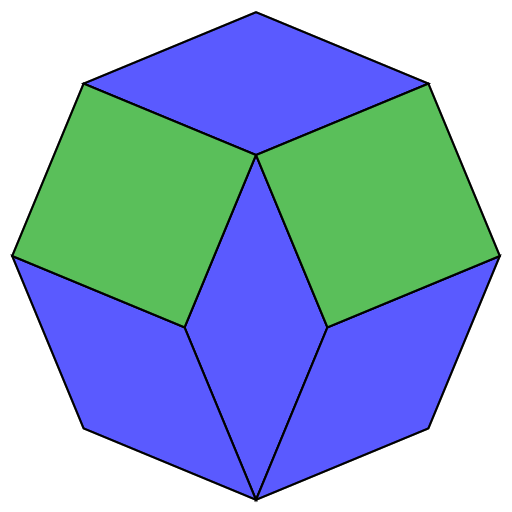In geometry, a zonogon is a centrally symmetric convex polygon.[1] Equivalently, it is a convex polygon whose sides can be grouped into parallel pairs with equal lengths and opposite orientations.

Examples
A regular polygon is a zonogon if and only if it has an even number of sides.[2] Thus, the square, regular hexagon, and regular octagon are all zonogons. The four-sided zonogons are the square, the rectangles, the rhombi, and the parallelograms.
Tiling and equidissection
The four-sided and six-sided zonogons are parallelogons, able to tile the plane by translated copies of themselves, and all convex parallelogons have this form.[3]
Every 2n-sided zonogon can be tiled by \( {\tbinom {n}{2}} \) four-sided zonogons.[4] In this tiling, there is one four-sided zonogon for each pair of slopes of sides in the 2 n {\displaystyle 2n} 2n-sided zonogon. At least three of the zonogon's vertices must be vertices of only one of the four-sided zonogons in any such tiling.[5] For instance, the regular octagon can be tiled by two squares and four 45° rhombi.[6]
In a generalization of Monsky's theorem, Paul Monsky (1990) proved that no zonogon has an equidissection into an odd number of equal-area triangles.[7][8]
Tessellation by irregular hexagonal zonogons
Regular octagon tiled by squares and rhombi
Other properties
In an n-sided zonogon, at most 2n-3 pairs of vertices can be at unit distance from each other. There exist n {\displaystyle n} n-sided zonogons with \( {\displaystyle 2n-O({\sqrt {n}})} \) unit-distance pairs.[9]
Related shapes
Zonogons are the two-dimensional analogues of three-dimensional zonohedra and higher-dimensional zonotopes. As such, each zonogon can be generated as the Minkowski sum of a collection of line segments in the plane.[1] If no two of the generating line segments are parallel, there will be one pair of parallel edges for each line segment. Every face of a zonohedron is a zonogon, and every zonogon is the face of at least one zonohedron, the prism over that zonogon. Additionally, every planar cross-section through the center of a centrally-symmetric polyhedron (such as a zonohedron) is a zonogon.
References
Boltyanski, Vladimir; Martini, Horst; Soltan, P. S. (2012), Excursions into Combinatorial Geometry, Springer, p. 319, ISBN 9783642592379
Young, John Wesley; Schwartz, Albert John (1915), Plane Geometry, H. Holt, p. 121, "If a regular polygon has an even number of sides, its center is a center of symmetry of the polygon"
Alexandrov, A. D. (2005), Convex Polyhedra, Springer, p. 351, ISBN 9783540231585
Beck, József (2014), Probabilistic Diophantine Approximation: Randomness in Lattice Point Counting, Springer, p. 28, ISBN 9783319107417
Andreescu, Titu; Feng, Zuming (2000), Mathematical Olympiads 1998-1999: Problems and Solutions from Around the World, Cambridge University Press, p. 125, ISBN 9780883858035
Frederickson, Greg N. (1997), Dissections: Plane and Fancy, Cambridge University Press, Cambridge, p. 10, doi:10.1017/CBO9780511574917, ISBN 978-0-521-57197-5, MR 1735254
Monsky, Paul (1990), "A conjecture of Stein on plane dissections", Mathematische Zeitschrift, 205 (4): 583–592, doi:10.1007/BF02571264, MR 1082876
Stein, Sherman; Szabó, Sandor (1994), Algebra and Tiling: Homomorphisms in the Service of Geometry, Carus Mathematical Monographs, 25, Cambridge University Press, p. 130, ISBN 9780883850282
Ábrego, Bernardo M.; Fernández-Merchant, Silvia (2002), "The unit distance problem for centrally symmetric convex polygons", Discrete and Computational Geometry, 28 (4): 467–473, doi:10.1007/s00454-002-2882-5, MR 1949894
Undergraduate Texts in Mathematics
Graduate Studies in Mathematics
Hellenica World - Scientific Library
Retrieved from "http://en.wikipedia.org/"
All text is available under the terms of the GNU Free Documentation License



